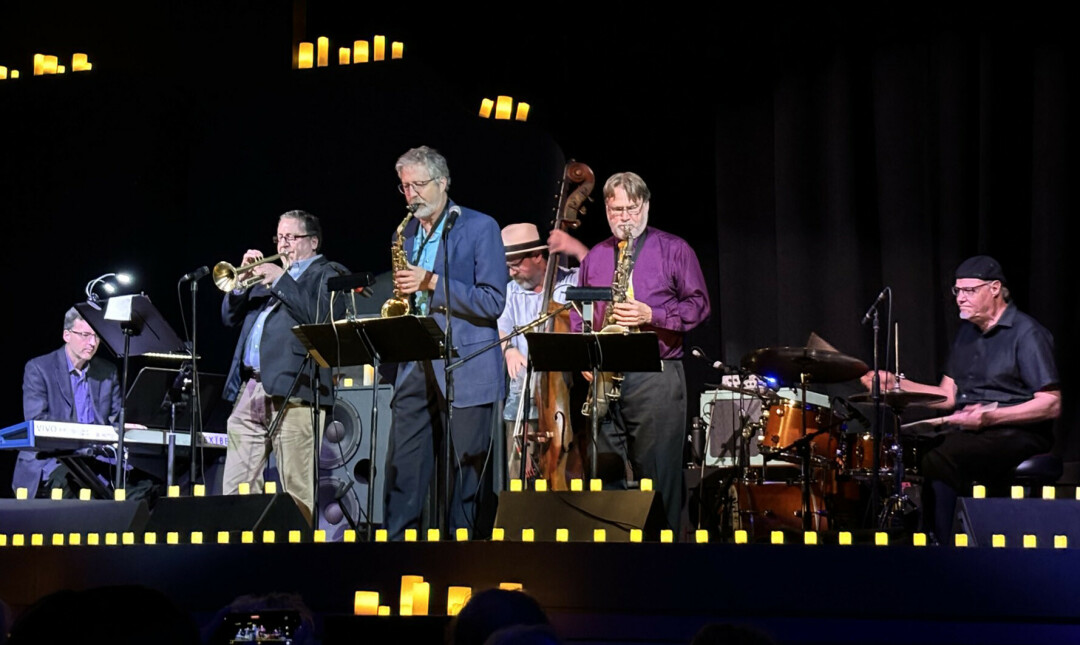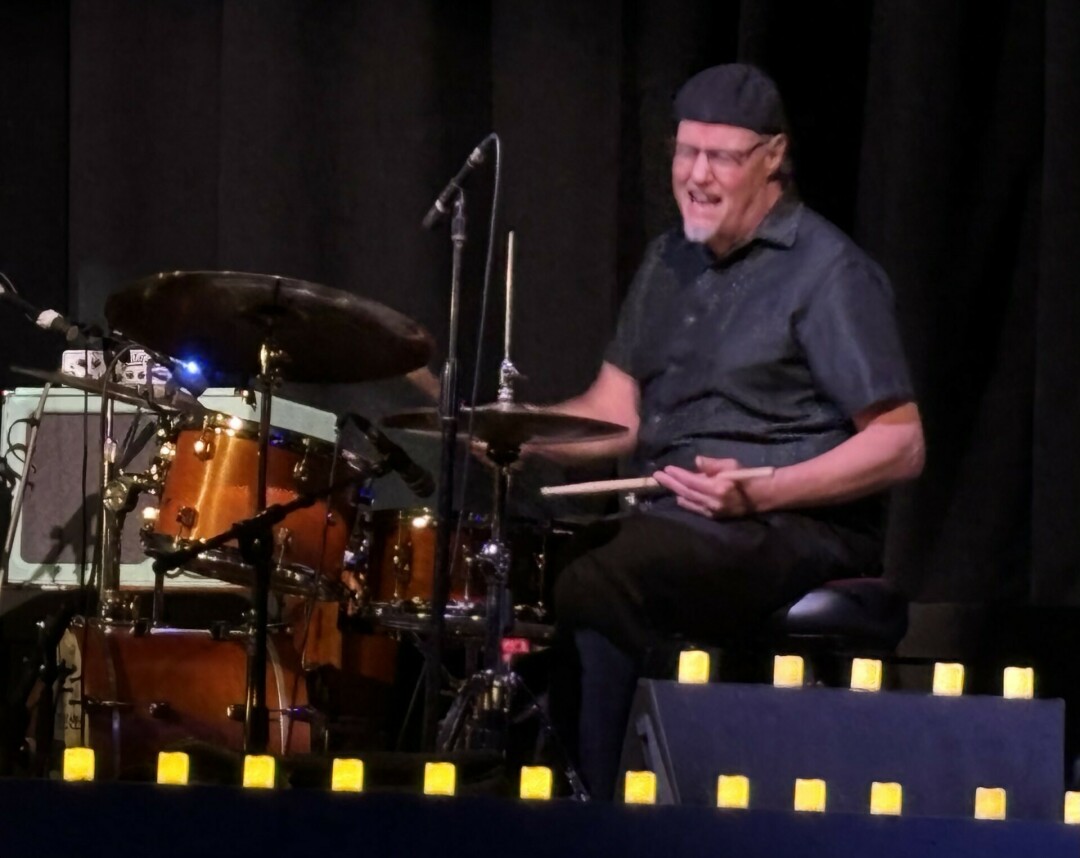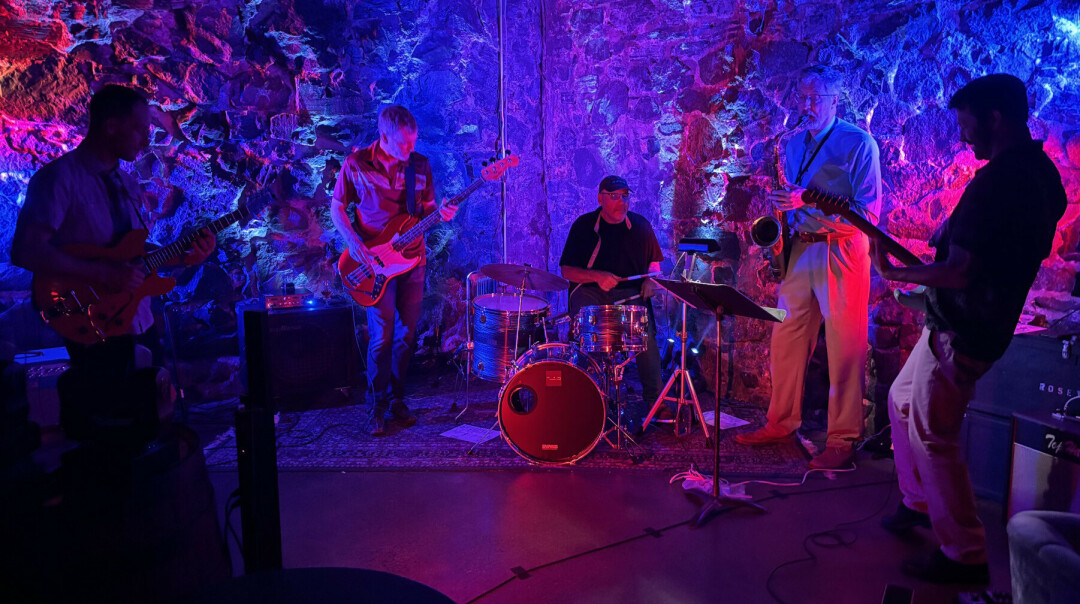The evolving sound of jazz

The candlelit Kind of Blue concert at the West Theatre. Photos by Jill Fisher.
The Kind of Blue concert at the West Theatre on Thursday, June 13, was a revelation about the evolution of jazz that I am just beginning to understand. The West was nearly sold out for this concert. which is a testament to the enduring attraction of this musical genre.
On this evening the tracks of the ground-breaking and iconic Miles Davis album, Kind of Blue, recorded and released in 1959, were reprised by David Edmund (trumpet) playing Davis’s parts, Randy Lee (alto sax) playing Cannonball Adderley’s parts, Paul Peterson (tenor sax) playing John Coltrane’s parts, Ryan Frane (keys) playing Bill Evans’s and Wynton Kelly’s parts, Gordon Lewis (standup bass) playing Paul Chambers’s parts and Rick Bruner (drums) playing Jimmy Cobb’s parts. Though the album was totally new to me, I found this evening of instrumental music to be wonderful, even exhilarating.
But there was more than just the tunes from that album in store since the entire first set included other Davis renditions not included on that recording: “Pfrancing" is a Davis original named for his first wife Frances, also known as “No Blues.” The tune "Dear Old Stockholm" was based on a Swedish folk song. (Who could tell? especially after having attended the Duluth Stámmen with all the attendant Scandinavian songs performed there.) "Autumn Leaves" is a popular song that’s become a jazz standard—it was based on the French song "Les Feuilles mortes" ("The Dead Leaves") composed by Joseph Kosma in 1945 with lyrics translated into English by Johnny Mercer.
The fourth number was the engaging "Down" and wrapping up the first set was "Milestones" the title track of Davis’s 1958 album, an upbeat tune peppered with staccato trumpet and sax notes.
The “Candlelit Session” for the concert turned out to provide an appropriate ambiance for this music. It was an enjoyable and fitting visual complement to the music of Miles Davis rather than the gimmick I first imagined it to be. The subtle lighting, sans flashing lights of changing colors that one must endure during many concerts at the West, was a welcome change. Although the name Miles Davis was familiar to me, his music wasn’t.
My early exposure to jazz was of the Dixieland variety my father was partial to with heavy emphasis on Louis Armstrong, Benny Goodman and Pete Fountain. The only other jazz musician I recall hearing early on was the drummer Buddie Rich when he periodically played on the Tonight Show with Johnny Carson. (I watched this TV show religiously throughout my teen years.) However, I was not drawn to it at that point in my life. Writing this column has made me curious about and wanting to understand jazz. Earlier this year I had the privilege of sitting in on Gordon Lewis’s Spring Semester Jazz Studies course at UMD. In it Gordon shared his knowledge of jazz, from its roots (African American working songs, field hollers and blues) through to contemporary forms, including ragtime, stride, boogie woogie, swing, bebop, hard bop, cool jazz, rock-fusion, etc. This survey course greatly expanded the world of jazz to me and consequently my admiration for the Kind of Blue album. Such was the impact of Miles Davis’s music conveyed by this concert that I made a trip to River City Records in Lincoln Park to see if I might track down that album. And I was in luck—a brand new LP of Kind of Blue was in stock. When I got home and put the album on my turntable I discovered even the vinyl was blue and I got to relive the music I first heard at the West. Besides this find, I came away with an unopened three-album set of Fats Waller’s work (a Time/Life issue that included a booklet about him and his career) and a used album The Bix Beiderbecke Story—Whiteman Days. Both of these early jazz greats were on my long list of jazz musicians I learned about in Lewis’s class.

Rick Bruner at the Kind of Blue concert
Listening to these albums back to back brought home just how much jazz has evolved and permeated musical expressions ever since. Fats Waller, pianist, organist, singer and composer, was considered the master of Harlem stride piano back in the 20s. He was a radio performer and personality who pushed the envelope with his sometimes racey off-the-cuff comments on air. Several of his pieces in this three-album set sounded like the music in old cartoons I saw on TV and loved as a kid, such as Betty Boop. Besides that, I was amazed by his jazzy organ pieces. Bix Beiderbecke played the cornet (self-taught) and piano and by all accounts was highly influential for other jazz musicians of his era. He remains a legendary player despite dying from alcoholism at the age of 28. His was the sound of hot Dixieland jazz that remains associated with the Roaring 20s, otherwise known as the “Jazz Age.” This is music that makes one want to dance the Charleston!
So what are the characteristics that define jazz? The one that seems universally agreed upon is the centrality of improvisation. Whether it’s a pop tune that gets embellished almost out of recognition by a jazz player, a polyrhythmic instrumental without any other musical reference, or scat vocalizations, it seems freeform improvisation most closely suggests that what we are hearing is jazz.
Thinking about jazz bands and performances hereabouts made me realize just how popular jazz remains (especially in comparison to the far smaller turnouts for blues concerts). The music programs at UMD and UWS that have strong jazz components are certainly one reason for that. Another may be the legendary Saratoga Jazz Quartet that played for decades in Canal Park. That group has morphed into the Jazz at the Depot after it was stripped of its home at the Saratoga Club. The Hot Club of Duluth plays primarily 20s and 30s jazz at its regular Rathskeller gig, while The Maxi Childs Trio, the house band at Black Water Lounge, plays lots of classic jazz tunes there on Tuesday and Thursday evenings. The Dan Nelson Trio based in Grand Marais occasionally makes it down to Duluth to play its repertoire of older jazz standards. More recently the young band, Jumpsuit, which has been in residency at Cedar Lounge on Wednesdays in June, has performed improvisational works that sound a lot like jazz to me.
Then there is the group Landscapes; in the January 26, 2023, issue of the Reader I wrote about them and classified this group of four as a jazz ensemble. However a recent chat with members Carl Olson and Garth Anderson, plus Randy Lee (who sat in on their regular Wednesday night gig at the Rathskeller on June 19) indicated they didn’t necessarily agree with my classification. Rather they suggested their work has “elements of jazz.” In fact, Lee thought “soundscape” was a more accurate description of their work. Yet in listening to their free flowing instrumentals (with two electric guitars, a bass guitar and drums) that give plenty of space for individual improvisational riffs, I can’t help but think their artistry is actually an extension and evolution of jazz. When asked how they develop their original material for performance, Olson explained that they outline certain chords and progressions in advance, which allows each of them to improvise around that structure. Is this really different than taking a known pop song/melody as a starting point for improvisation? Perhaps the music of Landscapes could justifiably be considered within the flow of jazz development.

Landscapes
My thinking about this was strengthened by a separate conversation I had with Jimi Cooper, who plays electric guitar with The Hot Club of Duluth. He asserted that the genre of jazz is not a museum piece but rather an evolving sound that synthesizes various musical influences, with emphasis on improvisation. He pointed out that the term jazz has been applied to a variety of styles that have developed in the last hundred-plus years, specifically those I noted above and were taught by Lewis in his Jazz Studies class. Some might insist that even if it cannot be closely defined, we know jazz when we hear it!
But returning to the candlelit Kind of Blue concert, I can’t say enough about how fine the musicians were, exemplified in improvised solos by each. It occurred to me that many, if not most, of the audience members knew the Miles Davis album well; thus the standing ovation the players received was surely a sign of just how true they were to the spirit of the album with their accomplished performance. Some noted bassist Lewis’s incredible stamina and energetic playing, others were blown away by Edmund’s trumpeting. Peterson lived up to his reputation as an outstanding saxophonist and was wonderfully complemented by Lee’s alto sax. Frane more than held his own with his piano interludes.
And then there was Bruner on drums, bringing his sensuous brush work, nuanced rhythms and the occasional bomb drop to provide grounding for the others’ meanderings. Lee told the audience that it was Bruner’s idea to perform Davis’s masterpiece along with selecting the additional Davis tunes to round out the concert. This made me remember Bruner saying how interested he was in jazz drumming when I profiled him in the January 5, 2023, issue of the Reader. Perhaps he will decide to organize a concert of another great jazz work. I do hope so.
Upcoming: It’s the time of year for outdoor music! Porch Fest gets started on Thursday, June 27 in Superior’s Northside neighborhood. The following week we have Duluth’s Concert in the Park Series continuing with Sydney Hansen at Chester Park on Tuesday, Pier B’s Courtside Concerts and Glensheen’s Concerts on the Pier series are both starting on Wednesday July 3. Lots will be happening at Earth Rider Festival Grounds too: Friday, June 28 with Mae Simpson and opener Mark Joseph & The American Soul (not to mention Cedar Lounge’s Weekend Primer 5-7 pm that day with Russ Sackett) and Twin Ports Does The Monterey Pop Festival 1967 all day Sunday, June 30. See you there!